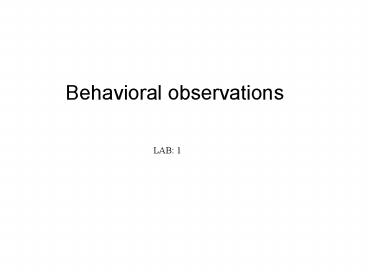Behavioral observations PowerPoint PPT Presentation
1 / 26
Title: Behavioral observations
1
Behavioral observations
LAB 1
2
Information which can be obtained (1)
- the presence or absence of the particular
activity - the frequency of occurrence of each activity
during the observation period - the duration of each bout of each activity
- the intensity of the activity at each occurrence
3
4th problem
- Evolution of Phylogeny
- How did the behavior evolved during the history
of the species ? - What factors were involved in molding the
behavior over the course of evolutionary history
?
4
Recording behavior
Direct observation Videotaping
Check sheets
Video recorder
Computer software
Tape-recorder
http//www.noldus.com/
5
Check Sheet Design
Categories of behavior
Independent variables (date time
observer subjects...)
Sample intervals
6
Preliminaries to measuring behavior
- Preliminary observation
- raw material for formulating questions and
hypotheses - choosing recording methods measures requires
some knowledge of the subject and their behavior
7
Ways to describe behavior
- The structure is the appearance, physical form or
temporal patterning of behavior. - run tip of bill along primary feather of
wing - The consequences are the effects of the subjects
behavior on the environment, on other individuals
or on itself. - obtain food escape from a predator
8
Ways to describe behavior
- The individuals spatial relation to features of
the environment or to other individuals. - emphasis where or with whom
- approach feeder leave nest
9
Choosing categories general guidelines
- Choose enough categories to describe the
behavior (provide background information) - too many difficult to record reliable data
- too few miss important background information
10
Choosing categories general guidelines
- Define precisely the categories
- Categories should be independent
- Categories should be generally homogeneous
11
Types of measure
- Latency (measured in units of time s
min. or h) - is the time from a specific event to the onset of
the first occurrence of the behavior. For
example, if a piglet suckles for the first time
15 minutes after being born, the latency to
suckle is 15 minutes
Birth Suckle (1) Suckle (2)
Suckle (3)
0 15min 35min
60min
12
Types of measure
- Latency (measured in units of time s
min. or h) - is the time from a specific event to the onset of
the first occurrence of the behavior. For
example, if a piglet suckles for the first time
15 minutes after being born, the latency to
suckle is 15 minutes
Birth Suckle (1) Suckle (2)
Suckle (3)
0 15min 35min
60min
13
Types of measure
- Frequency (measured in reciprocal units
of time e.g., s-1 , min.-1 or h-1) - is the number of occurrences of the behavior
pattern per unit of time. For example, if a
piglet suckles 3 times during a 60 minutes
recording session, the frequency of suckling is 3
h-1.
Suckle (1) Suckle (2)
Suckle (3)
0 15min 35min
60min
14
Types of measure
- Duration (measured in units of time e.g.,
s , min. or h ) - is the length of time for which a single
occurrence of the behavior pattern lasts. For
example, if a piglet starts suckling and stops 20
s later, the duration of that suckling period was
20 s.
total duration 60 s/h
Suckle (1) Suckle (2)
Suckle (3)
proportion 60/3600 0.016
mean duration 123/320 s
0 15min 35min
60min
15
Types of measure
- Intensity
- the number of component acts per unit of time.
For example, the sound intensity of the
vocalization (piglet or sow) that precedes milk
ejection.
Suckle (1) Suckle (2)
Suckle (3)
0 15min 35min
60min
16
Information which can be obtained (1)
- 1) the presence or absence of the particular
activity - 2) the frequency of occurrence of each activity
during the observation period - 3) the duration of each bout of each
activity - 4) the intensity of the activity at each
occurrence
17
Information which can be obtained (2)
- the latency of occurrence of the activity after
some stimulus or previous action - the timing and nature of subsequent activities
- the timing and nature of behavior changes in
relation to physiological changes.
18
Events versus States
- Events
- behavioral patterns of relatively short duration
- discrete body movements
- vocalizations
19
Events versus States
- States
- behavioral patterns of relatively long duration
- body postures
- resting, feeding, drinking
20
Sampling rules
- Ad libitum sampling
- no systematic constraints are placed
1
3
7
2
4
6
5
21
Sampling rules
- Focal sampling
- one animal (one litter...) for a specified amount
of time
2 5 4 1 3 6 2
3
2
7
60 min.
1
700-1000 1200-1500
4
5
6
22
Sampling rules
- Scan sampling
- the whole group is scanned at regular intervals
2 5 4 1 3 6 2
3
2
7
60 min.
1
700-1000 1200-1500
4
5
6
23
Sampling rules
- Behavior sampling
- the whole group is observed and each occurrence
of a particular behavior is recorded
5
7
2
7
3
7
24
Sampling rules
Ad libitum sampling
Focal sampling
Scan sampling
Behavior sampling
Recording rules
Time sampling
Continuous recording
One-zero sampling
Instantaneous sampling
25
Recording rules
- Continuous recording
- each occurrence of the behavior is recorded
- times at which a behavior pattern occurs (events)
- behavioral pattern start and finishing time
(states)
Behavior
Receiver
start
end
Performer
outcome
bull 7
gc
730
735
5
gb
gc groom cow gbgroom performer
Focal
26
Recording rules
- Time sampling
- a) instantaneous sampling (freeze picture)
- b) one-zero sampling (occurred or not)
- register the occurrence of the behavior using
sample intervals
b)
Sample
grazing
drinking
walking
idle s. idle l.
other
a)
700
1 2 5 6 7
3 2
702

